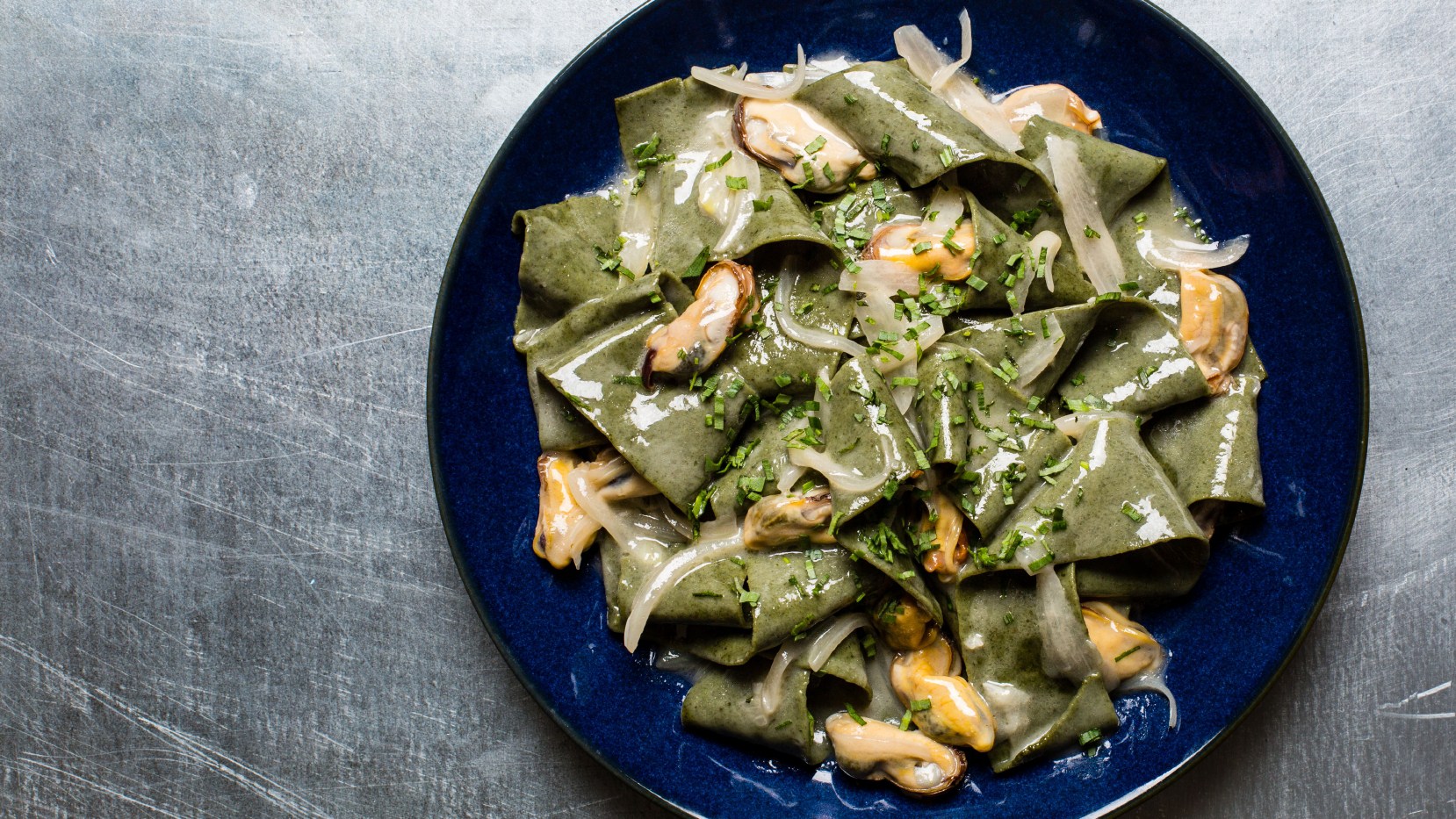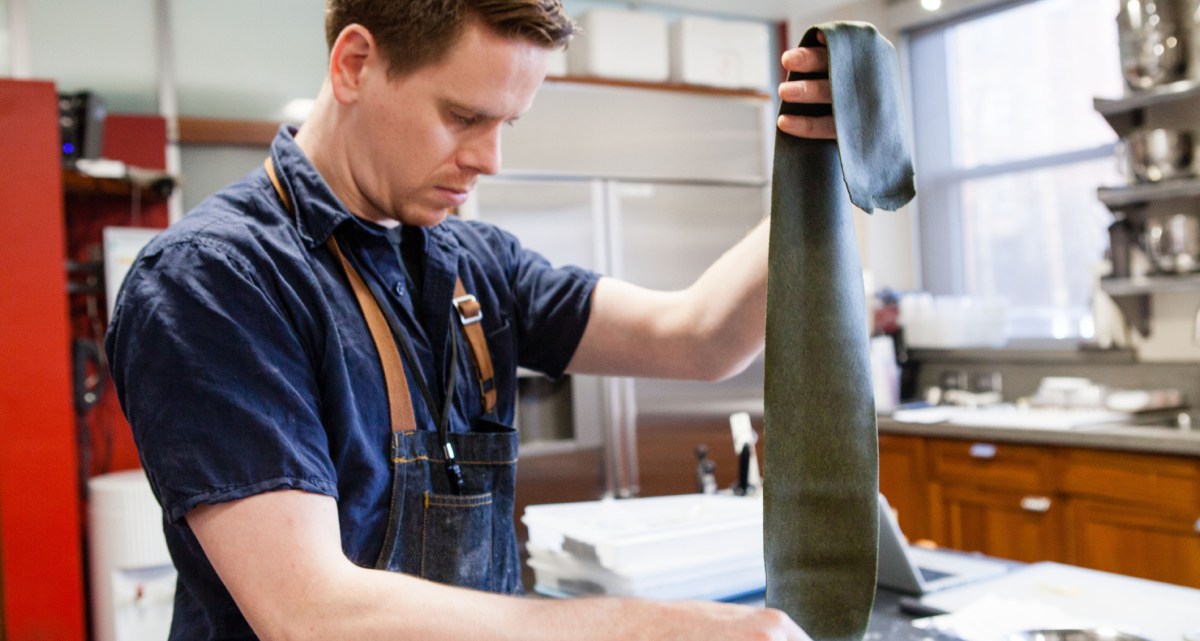In this weekly series, Associate Editor Tim Chin and Test Cook Sasha Marx take you behind the scenes of Cook’s Science and give you a glimpse into our recipe development process, from how we come up with recipe ideas, to test kitchen failures, to discoveries we make along the way. This week, Sasha talks pasta and how we put recipes through the wringer before they’re published.
“How did you come up with that?” is a question Tim and I get asked a lot. And the answer truly varies from recipe to recipe. I usually draw on a combination of past cooking and eating experience, cookbooks, visuals, and word association when I’m brainstorming ideas for a dish. To give a better sense of this process, I thought it would be fun to look in detail at the development process for the nori pasta dough that I used in two recent recipes, Nori Pappardelle with Mussels and Butter, and Nori Pappardelle with Blistered Cherry Tomatoes.
You can read about my inspiration for the pasta in the “Back to the Test Kitchen” section of our feature story “In The Weeds,” which is a fascinating look at the current state of seaweed and seaweed farming. What doesn’t make it into that narrative is all the testing and tweaking that went into developing the nori pasta dough for the pappardelle. To get as much seaweed flavor as possible into the pasta, I drew on my experience from past restaurant jobs where I worked with nori powder (dried sheets of nori seaweed, like the ones used to wrap sushi rolls, ground to a fine powder). Nori is easy to find in grocery stores, and packs a lot of concentrated toasty seaweed flavor, so a little goes a long way. I wanted to see if I could incorporate nori powder into an egg-based pasta by mixing it with the dry ingredients of the dough (flour and salt) before adding the wet ingredients (eggs, extra-virgin olive oil, and water).
For my first attempt, I began with a small amount of nori powder (7 grams or 2 tablespoons) added to 285 grams (2 cups) of all-purpose flour. The resulting dough was an unattractive pale army green, and it didn’t bring enough seaweed flavor when the cooked pasta was eaten on its own, let alone with any kind of sauce. The dough also didn’t have enough chew—all-purpose flour doesn’t have very high protein content, so it forms a somewhat weak gluten network. Cutting the amount of flour to make room for the nori powder meant even less gluten and an adverse effect on the texture of the pasta. Nobody likes mushy pasta. We needed to bump up both the nori factor and the chew factor. For that to happen, the team agreed that I should see how much nori powder I could add and still end up with a workable dough. To bolster chew, I would also try subbing higher-protein bread flour for the all-purpose flour, a tactic Tim had success with when developing his hand-pulled noodle recipe.
The shape of the pasta was also important. For that first test batch I had rolled the dough into sheets with a pasta roller, before cutting it into fettuccine. We all agreed that fettuccine were too thin, and we wanted a more substantial noodle. A wider and thicker noodle, like pappardelle, was going to be the way to go. Bonus: they evoked the natural shape of sugar kelp, too.
For the second round of dough testing I made four batches of dough with increasing amounts of nori powder (14 grams, 21 grams, 28 grams, and 35 grams, respectively). I reduced the amount of flour in each batch to 225 grams (1½ cups), and used bread flour instead of all-purpose. As I had done with the first round of testing, I made the dough using a stand mixer. The doughs in this second round required more water to come together due to the higher protein content of bread flour (which leads to a higher water absorption rate), combined with the increased amount of nori (which also absorbs moisture very well). Water is necessary in a dough (be it bread, pizza, or pasta) to form the gluten network that provides chew, but there can be too much of a good thing. Too much liquid in a dough can actually dilute and weaken the gluten it typically works so well to build. The dough with the highest amount of nori powder (35 grams) required too much water (56 grams, which is ¼ cup!), and even after extensive kneading (10 minutes), the dough fell apart when run through a pasta roller. That left us with three workable doughs that I was able to successfully roll out and cut into pappardelle.
I cooked off portions of these three doughs for a team tasting. The unanimous favorite was the version with the greatest amount of nori powder (28 grams). Along with having the most nori flavor, meaning it could stand up to saucing without being drowned out, it was the most visually striking: the dough took on a deep, dark green color that made the pappardelle actually look like kelp. Mission accomplished, right? Not so fast.

While most of the development process focuses on getting to a working recipe, we also spend time on the back end to pick that working recipe apart and make sure it’s optimized for the home cook. This means asking questions like: If the dough can be made in a stand mixer, can it also be made in a food processor? Answer: Yes, a dough can be formed but the food processor doesn’t achieve the same level of kneading as a stand mixer, and the resulting pasta will have inferior chew.
If the dough calls for whole eggs, egg yolks, and water, can the amount of water be cut by increasing the number of whole eggs and using fewer separated yolks (seeing as egg whites are 90% water)? Answer: Yes, and the final recipe reflects that change.
What is the minimum resting time for the dough after kneading? Answer: 30 minutes, unless you have a commercial chamber vacuum sealer at home, which can be used to accelerate the absorption of water into flour that usually happens slowly as a dough rests.
If the dough is rested in a refrigerator, how long does it need to wait at room temperature before it can be rolled out into pasta sheets? Answer: 10 minutes.
For every recipe, Tim and I go through additional rounds of “abuse testing” to answer these types of questions, and to find out what might cause our working recipes to fail under various sets of circumstances. A lot of this behind the scenes testing never makes it into the published version of a recipe, but it’s valuable for troubleshooting issues when readers have questions about one of our recipes.
With the dough recipe squared away, I could turn my attention to building a set (restaurant jargon for the components that make up a dish) to accompany the pasta. I made the mistake of making two very different dishes, hoping we would prefer one over the other. We liked both. Denying people pasta goes against everything I believe in so I volunteered to develop both versions. Should be easy, right?
[Editor’s Note: Check out the results of Sasha’s hard work: Nori Pappardelle with Mussels and Butter and Nori Pappardelle with Blistered Cherry Tomatoes.]




